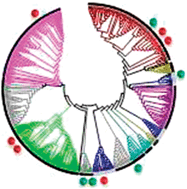Comparative genomics analysis of completely sequenced microbial genomes reveals the ubiquity of N-linked glycosylation in prokaryotes†
Abstract

a
Department of Biosciences and Bioengineering, Indian Institute of Technology Bombay, Powai, Mumbai 400 076, India
E-mail:
balaji@iitb.ac.in
Fax: +91-22-2572 3480
Tel: +91-22-2576 7778

 Please wait while we load your content...
Something went wrong. Try again?
Please wait while we load your content...
Something went wrong. Try again?
M. Kumar and P. V. Balaji, Mol. BioSyst., 2011, 7, 1629 DOI: 10.1039/C0MB00259C
To request permission to reproduce material from this article, please go to the Copyright Clearance Center request page.
If you are an author contributing to an RSC publication, you do not need to request permission provided correct acknowledgement is given.
If you are the author of this article, you do not need to request permission to reproduce figures and diagrams provided correct acknowledgement is given. If you want to reproduce the whole article in a third-party publication (excluding your thesis/dissertation for which permission is not required) please go to the Copyright Clearance Center request page.
Read more about how to correctly acknowledge RSC content.
 Fetching data from CrossRef.
Fetching data from CrossRef.
This may take some time to load.
Loading related content
